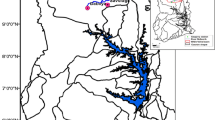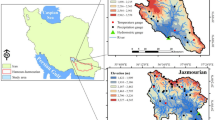Abstract
As an essential tool to bridge the gap between climatic output and hydrological input, the precipitation spatial downscaling (PSD) method exhibits divergent performance in terms of different evaluation objectives. This study compared and analysed the performance of the three PSD methods using two evaluation objectives - precipitation (P) and possible effective precipitation (PEP), and evaluated the effect of different downscaled precipitation on regional flow simulation by constructing an ideal model and a real case based on the Vertical Mixed Runoff (VMR) model. Results show that when the evaluation objective changes from P to PEP, the Artificial Neural Network replaces the Weather Research & Forecasting Model as the dominant PSD model. In spatial analysis, the statistical PSD models perform significantly better when using PEP, compared to P. In temporal analysis, the PEP biases are more stable compared to the P biases from the same PSD model. The validation in the ideal case and the actual basin further proves that taking PEP as the evaluation objective can improve the reliability of the PSD method selection for hydrological research.




Similar content being viewed by others
Data Availability
The observation of daily precipitation and evaporation from the year 2006 to 2017 are openly available from the National Meteorological Information Center at http://data.cma.cn. All the climate datasets are from the NCAR Community Earth System Model (CESM CMIP5) datasets at https://rda.ucar.edu/datasets/ds316.1/.
References
Abbaspour KC, Rouholahnejad E, Vaghefi S et al (2015) A continental-scale hydrology and water quality model for Europe: Calibration and uncertainty of a high-resolution large-scale SWAT model. J Hydrol 524:733–752. https://doi.org/10.1016/j.jhydrol.2015.03.027
Azmat M, Qamar MU, Ahmed S, Shahid MA, Hussain E, Ahmad S, Khushnood RA (2018) Ensembling downscaling techniques and multiple GCMs to improve climate change predictions in cryosphere scarcely-gauged catchment. Water Resour Manag 32:3155–3174
Bao WM, Wang CL (1997) Vertically-mixed runoff model and its application. Hydrology 000(003):18–21 (in Chinese)
Bao W, Zhao L (2014) Application of linearized calibration method for vertically mixed runoff model parameters. J Hydrol Eng 19(8):04014007. https://doi.org/10.1061/(asce)he.1943-5584.0000984
Bo X (2019) Instructions and case studies of multiple air quality models (SMOKE, WRF, CMAQ, etc.). China Environmental Science Press, Beijing
Bruyère CL et al (2013) Bias corrections of global models for regional climate simulations of high-impact weather. Clim Dyn 43(7–8):1847–1856. https://doi.org/10.1007/s00382-013-2011-6
Chen J, Brissette FP, Chaumont D, Braun M (2013) Finding appropriate bias correction methods in downscaling precipitation for hydrologic impact studies over North America. Water Resour Res 49(7):4187–4205. https://doi.org/10.1002/wrcr.20331
Cho J, Oh C, Choi J, Cho Y (2016) Climate change impacts on agricultural non-point source pollution with consideration of uncertainty in CMIP5. Irrig Drain 65:209–220. https://doi.org/10.1002/ird.2036
Clark MP, Kavetski D, Fenicia F (2011) Pursuing the method of multiple working hypotheses for hydrological modeling. Water Resour Res 47(9). https://doi.org/10.1029/2010wr009827
Dawson CW, Wilby RL (2001) Hydrological modelling using artificial neural networks. Prog Phys Geogr 25(1):80–108. https://doi.org/10.1177/030913330102500104
Dunne T, Leopold LB (1978) Water in environmental planning. Macmillan
Fan L, Chen D, Fu C et al (2013) Statistical downscaling of summer temperature extremes in Northern China. Adv Atmos Sci 30:1085–1095. https://doi.org/10.1007/s00376-012-2057-0
Fiseha BM, Setegn SG, Melesse AM, Volpi E, Fiori A (2014) Impact of climate change on the hydrology of upper Tiber River Basin using bias corrected regional climate model. Water Resour Manag 28:1327–1343
Gashaw T, Tulu T, Argaw M, Worqlul AW (2018) Modeling the hydrological impacts of land use/land cover changes in the Andassa watershed, Blue Nile Basin, Ethiopia. Sci Total Environ 619–620:1394–1408. https://doi.org/10.1016/j.scitotenv.2017.11.191
Giorgi F, Mearns LO (1991) Approaches to the simulation of regional climate change: a review. Rev Geophys 29(2):191. https://doi.org/10.1029/90rg02636
Goyal MK, Ojha CSP (2010) Evaluation of linear regression methods as downscaling tools in temperature projections over the Pichola Lake Basin in India. Hydrol Process 25(9):1453–1465. https://doi.org/10.1002/hyp.7911
Hanssen-Bauer I, Achberger C, Benestad RE et al (2005) Statistical downscaling of climate scenarios over Scandinavia. Clim Res 29:255–268. https://doi.org/10.3354/cr029255
Horton RE (1933) The role of infiltration in the hydrologic cycle. Eos Trans Am Geophys Union 14(1):446–460
Huang P, Li Z, Yao C, Li Q, Yan M (2016) Spatial combination modeling framework of saturation-excess and infiltration-excess runoff for semihumid watersheds. Adv Meteorol 2016
Kour R, Patel N, Krishna AP (2016) Climate and hydrological models to assess the impact of climate change on hydrological regime: a review. Arab J Geosci 9:544. https://doi.org/10.1007/s12517-016-2561-0
Le Moine N, Andréassian V, Perrin C, Michel C (2007) How can rainfall-runoff models handle intercatchment groundwater flows? Theoretical study based on 1040 French catchments. Water Resour Res 43(6). https://doi.org/10.1029/2006wr005608
LeCun Y, Bengio et al (2015) Deep learning. Nature 521(7553):436–444
Li Z et al (2017) Non-point source pollution changes in future climate scenarios: a case study of Ashi River, China. Fresenius Environ Bull 26(11):6621–6631
MacQueen J (1965) Some methods for classification and analysis of multivariate observations. In Proceedings of the 5th Berkeley Symposium on Mathematical Statistics and Probability, p 281
Maraun D et al (2010) Precipitation downscaling under climate change: Recent developments to bridge the gap between dynamical models and the end user. Rev Geophys 48(3). https://doi.org/10.1029/2009rg000314
Ramteke G, Singh R, Chatterjee C (2020) Assessing impacts of conservation measures on watershed hydrology using MIKE SHE model in the face of climate change. Water Resour Manag 34:4233–4252
Ronghao CHU, Shuanghe SHEN, Meng LI et al (2018) Comparative analysis of small and E-601 pan evaporation and its conversion coefficient——Taking Jiangsu province as an example. J Meteorol Sci 38(02):247–257 (in Chinese)
Salehnia N et al (2019) Comparing the performance of dynamical and statistical downscaling on historical run precipitation data over a semi-arid region. Asia-Pacific J Atmos Sci. https://doi.org/10.1007/s13143-019-00112-1
Shi C, Wei B et al (2021) A quantitative discriminant method of elbow point for the optimal number of clusters in clustering algorithm. EURASIP J Wirel Commun Netw 2021(1):1–16
Si W, Bao W, Gupta HV (2015) Updating real-time flood forecasts via the dynamic system response curve method. Water Resour Res 51(7):5128–5144. https://doi.org/10.1002/2015wr017234
Skamarock WC et al (2019) A description of the advanced research WRF model version 4. National Center for Atmospheric Research: Boulder, CO, USA 145:145
Srivastava PK, Han D, Ramirez MR, Islam T (2013) Machine learning techniques for downscaling SMOS satellite soil moisture using MODIS land surface temperature for hydrological application. Water Resour Manag 27:3127–3144
Sun F, Roderick ML et al (2011) Hydroclimatic projections for the Murray-Darling Basin based on an ensemble derived from Intergovernmental Panel on Climate Change AR4 climate models. Water Resour Res 47(12). https://doi.org/10.1029/2010wr009829
Tokarska KB, Gillett NP (2018) Cumulative carbon emissions budgets consistent with 1.5 C global warming. Nat Clim Chang 8(4):296–299
Vetter T, Reinhardt J, Flörke M et al (2017) Evaluation of sources of uncertainty in projected hydrological changes under climate change in 12 large-scale river basins. Clim Change 141:419–433. https://doi.org/10.1007/s10584-016-1794-y
Wang Q, Huang J, Liu R et al (2020) Sequence-based statistical downscaling and its application to hydrologic simulations based on machine learning and big data. J Hydrol 124875. https://doi.org/10.1016/j.jhydrol.2020.124875
Wilcke RAI, Mendlik T, Gobiet A (2013) Multi-variable error correction of regional climate models. Clim Change 120(4):871–887. https://doi.org/10.1007/s10584-013-0845-x
Xu CY (1999a) Climate change and hydrologic models: a review of existing gaps and recent research developments. Water Resour Manag 13:369–382
Xu CY (1999b) From GCMs to river flow: a review of downscaling methods and hydrologic modelling approaches. Prog Phys Geograph 23(2):229–249
Xu Z, Han Y, Yang Z (2018) Dynamical downscaling of regional climate: a review of methods and limitations. Sci China Earth Sci. https://doi.org/10.1007/s11430-018-9261-5
Yang C, Wang N, Wang S, Zhou L (2016) Performance comparison of three predictor selection methods for statistical downscaling of daily precipitation. Theor Appl Climatol 131(1–2):43–54. https://doi.org/10.1007/s00704-016-1956-x
Acknowledgements
The study is financially supported by the National Key Research and Development Program of China (2019YFC0409000), the National Natural Science Foundation of China (52179011), and the Fundamental Research Funds for the Central Universities (2019B41014). Besides, this paper was supported by the High Performance Computing Platform of Hohai University, China.
Funding
The study was financially supported by the National Key Research and Development Program of China (Grant number 2019YFC0409000), the National Natural Science Foundation of China (Grant number 52179011), the Fundamental Research Funds for the Central Universities (Grant number 2019B41014).
Author information
Authors and Affiliations
Contributions
All authors contributed to the study conception and design. Material preparation, data collection and analysis were performed by Xumin Zhang, Simin Qu and Jijie Shen. The first draft of the manuscript was written by Xumin Zhang. Yingbing Chen, Xiaoqiang Yang, Peng Jiang and Peng Shi commented on previous versions of the manuscript. All authors read and approved the final manuscript.
Corresponding author
Ethics declarations
Ethical Approval
Not applicable.
Consent to Participate
Not applicable.
Consent to Publish
The Author confirms:
-
that the work described has not been published before (except in the form of an abstract or as part of a published lecture, review, or thesis);
-
that it is not under consideration for publication elsewhere;
-
that its publication has been approved by all co-authors, if any;
-
that its publication has been approved (tacitly or explicitly) by the responsible authorities at the institution where the work is carried out
The Author transfers to the Founder of the journal (Pisarenko Institute of Problems of Strength of the National Academy of Science of Ukraine) the exclusive right to the presented paper, including the right to publish the paper in the English language.
The copyright is transferred when the article is accepted for publication.
The author warrants that his/her contribution is original and that he/she has full power to make this consent. The author signs for and accepts responsibility for releasing this material on behalf of any and all co-authors. The copyright transfer covers the exclusive right to reproduce and distribute the article, including reprints, translations, photographic reproductions, microform, electronic form (offline, online) or any other reproductions of similar nature.
Competing Interests
The authors declare that they have no known competing financial interests or personal relationships that could have appeared to influence the work reported in this paper.
Additional information
Publisher's Note
Springer Nature remains neutral with regard to jurisdictional claims in published maps and institutional affiliations.
Rights and permissions
Springer Nature or its licensor (e.g. a society or other partner) holds exclusive rights to this article under a publishing agreement with the author(s) or other rightsholder(s); author self-archiving of the accepted manuscript version of this article is solely governed by the terms of such publishing agreement and applicable law.
About this article
Cite this article
Zhang, X., Qu, S., Shen, J. et al. Effect of Distinct Evaluation Objectives on Different Precipitation Downscaling Methods and the Corresponding Potential Impacts on Catchment Runoff Modelling. Water Resour Manage 37, 1913–1930 (2023). https://doi.org/10.1007/s11269-023-03462-8
Received:
Accepted:
Published:
Issue Date:
DOI: https://doi.org/10.1007/s11269-023-03462-8





